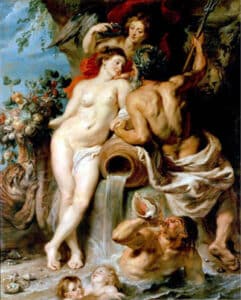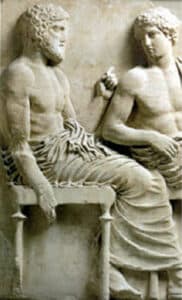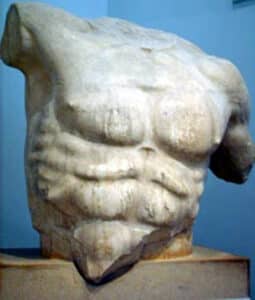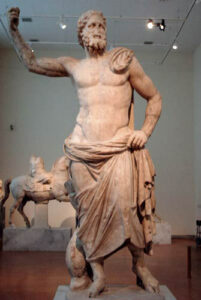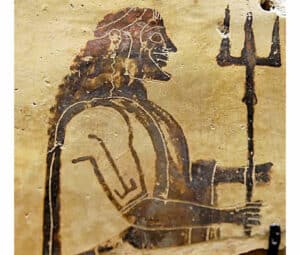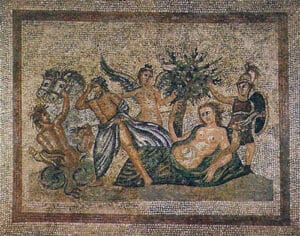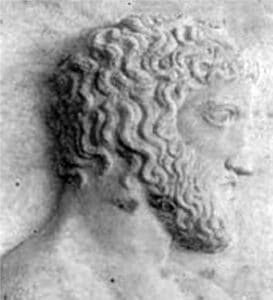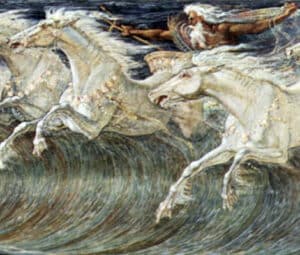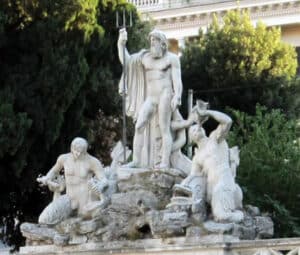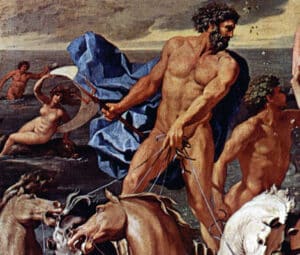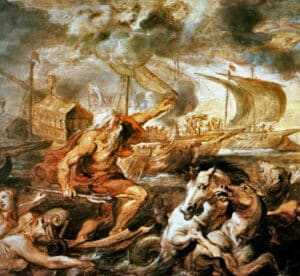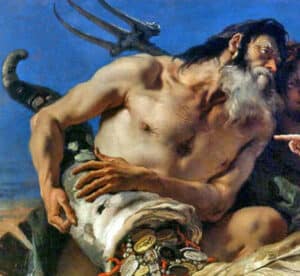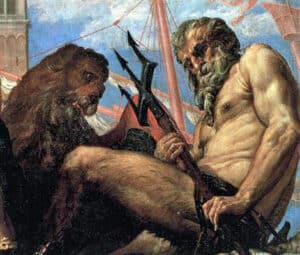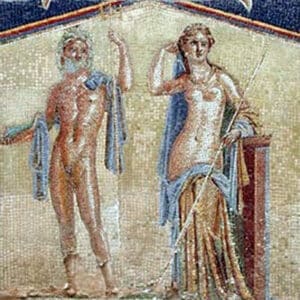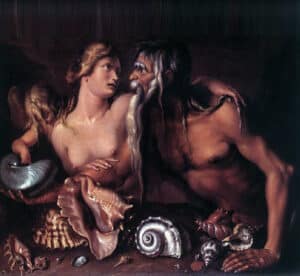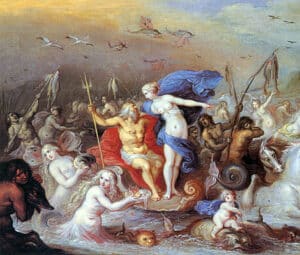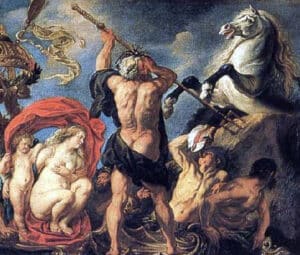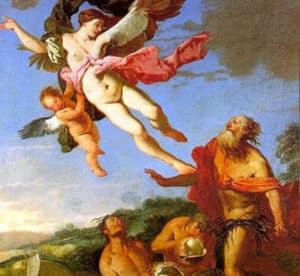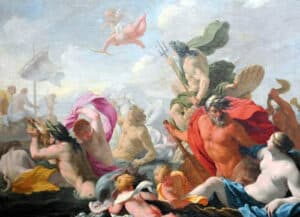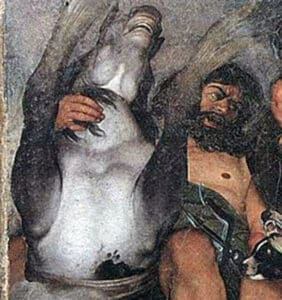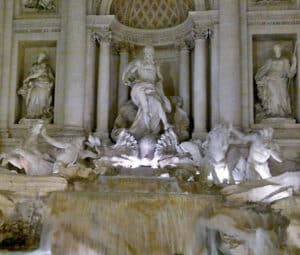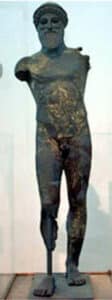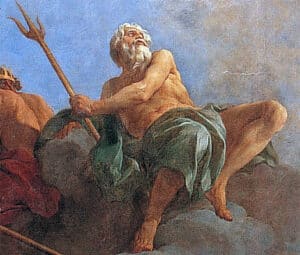Poseidon is one of the Olympians. He is the Greek god of the sea, storms, earthquakes, and horses. Poseidon was one of Zeus’ two brothers and the most ancient Greek water deity. After the Olympians won Titanomachy, he took control of the sea. His many disputes with gods and men made him known as violent, ill-tempered, and hot-blooded. He uses the trident as his primary symbol and weapon.
Key Facts
Family tree
| Parents | Cronus and Rhea |
| Partner(s) | Amphitrite, Aphrodite, Demeter |
| Siblings | Hestia, the virgin goddess of the hearth, Hades, the god of the underworld, Hera, Zeus, Demeter, and Chiron |
| Offspring | Aeolos, Agenor, Arion, Asopos, Atlas, Belus, Chrysaor, Chryssomalus, Cymopolea, Laestrygon,Neleus, Orion, The Celestial Hunter, Pegasus, the winged horse, Polyphemus, The One-Eyed Giant, Proteus, Rhodos, Theseus, Triton and others |
Names
| Roman Name | Neptune |
| Other Names | Posidon |
| Ancient Greek | Ποσειδῶν |
| The God of | Sea, storms, earthquakes, and horses |
| Symbols | Trident, fish, dolphin, horse, bull |
Name and Etymology
It is unknown where the name Poseidon came from. According to one theory, it means “husband of the earth” or “lord of the earth” and is derived from the Greek words “πόσις” and “δα”, common with Demeter. Another theory is that it is derived from the words “Ποσις” and “δᾶϝον” which means water. This second element is derived from the Proto-Indo-European *dah₂- “water” or *dʰenh₂- “to run, flow. So, according to this theory, Poseidon means the “monster of the sea” or the “lord of the sea”.
Plato proposed the other two possible etymologies. The first was that Poseidon derives from the words “foot-bond” (ποσίδεσμον), which means that the sea restrained Poseidon while he walked. The second was that Poseidon derives from the words “πολλά εἰδότος”, implying that he was very knowledgeable.
Po-se-da-o and Po-se-da-wo-ne are the first occurrences of the god’s name in Linear B. In Mycenaean Greek, these are Poseidan and Poseidawonos.
Poseidon appears to be based on Potis, an indigenous, pre-Greek Indo-European god. The Greek-speaking people who arrived in Arcadia during the Bronze Age blended their religious beliefs with those of the indigenous people. As a result, Poseidon has characteristics described in northern European folklore. One of these characteristics is that he appears to be a beast, similar to a horse, related to the liquid element, and presented as the river spirit of the underworld. The Romans associate him with Neptune and there is no direct Egyptian equivalent – maybe Sobek, Khnum or other water deities. His equal from Norse mythology is the Vanir god Njord, father to Freyja and Freyr.
Poseidon’s Origins and Family
Poseidon is a deity from the Bronze Age and Mycenaean civilization, as evidenced by Linear B inscriptions. He was one of Mycenae’s most important gods. People said that Poseidon bestowed excellent navigational skills upon them.
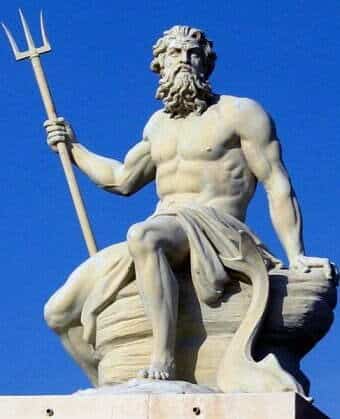
In later Greek mythology, Poseidon was one of the sons of the Titans Cronus and Rhea. Cronus swallowed all of his siblings except Zeus because he feared his children would dethrone him. When Zeus reached maturity, he forced Cronus to cough up all of his siblings, including Poseidon.
He was one of the most powerful Olympian gods. As such, he played an important role in the Titanomachy, the battle between the Titans and the Olympians for control of the universe. Following the victory of the Olympians, Poseidon and his two brothers, Zeus and Hades, reigned over the sea, the sky, and the underworld, respectively.
Poseidon lived in beautiful golden mansions beneath the sea, and his palace had the god’s stables of fine white horses near Aegae in Euboea.
Poseidon’s Lovers
Poseidon, like his brother Zeus, had many lovers, both males and females. Some of these love affairs were mutual, while others did not have his love interest’s explicit consent. They were an interesting mix of mortals and immortals. The most well-known are Amphitrite, Demeter, Aphrodite, Medusa, Alcyone, Patroclus, Pelops, Cleito, Nerites, Helle, Libya, and Eurynome.
Amphitrite
Amphitrite was the official consort and wife of Poseidon, a Nereid and Oceanid. She was a mother figure to seals, dolphins, and a variety of sea monsters. She was revered as a queen alongside Poseidon, as depictions show her standing next to him on his chariot or throne.
They first met in Naxos, where Amphitrite was dancing with her Nereid sisters. Poseidon fell in love at first sight, but according to some versions of the story, Amphitrite did not want him as her lover and fled from him. Poseidon then dispatched a dolphin to pursue her and persuade her to change her mind.
Amphitrite eventually returned and became queen. As a reward for his service, the dolphin became a constellation. Poseidon was unfaithful to his wife, as one might expect, but they didn’t seem to have many fights over it.
Demeter
Demeter is one of the original six Olympians, the daughter of Cronus and Rhea, and the sister of Poseidon. Poseidon desired her despite the fact that she was his sister. Demeter, on the other hand, didn’t want him and didn’t like his persistence. To avoid his advances, she decided to disguise herself as a mare and hide among the horses.
Unfortunately, because he was the god of horses, he had no trouble finding her. To avoid being seen by Demeter, he disguised himself as a stallion and captured her. They mated while both in the form of horses, and Demeter got pregnant in the process.
Demeter then gave birth to Despoina, a humanoid goddess of mystery, and Areion, a black stallion. Her younger children were Despoina and Areion, while her first child was Persephone, daughter of Zeus and wife of Hades.
Aphrodite
Aphrodite is the goddess of love and beauty, as well as the niece or aunt of Poseidon, depending on how mythological stories about her birth are told. Some of them identified Zeus as her father, while others identified Ouranos.
Many gods, including Hermes, God of All Trades, Dionysus, the god of wine and revelry, and Ares, were Aphrodite’s lovers. Poseidon was one of them. Their love affair was brief, but Poseidon was very supportive. Even after she began her secret romantic affair with Ares, he assisted them in escaping a trap set by Aphrodite’s husband, Hephaestus.
Medusa
The story of Medusa and Poseidon may be regarded as one of the first cases of victim blaming. Medusa was a lovely young woman who was raped by Poseidon in one of Athena’s temples. Because Athena could not punish her brother, she blamed Medusa and turned her and her sisters into Gorgons, The Enigmatic Sisters.
According to most versions of the story, Perseus went to behead Medusa so he could use her petrifying abilities against a man who wished to marry his mother. All of the Olympians helped him, especially Athena, who gave him a shield to aid him in his endeavor. Perseus, The Legendary Slayer of Medusa murdered Medusa while she was pregnant with Poseidon’s children, Pegasus, a winged horse, and Chrysaor, a giant wielding a golden sword.
Alcyone and Celaeno
Alcyone was a Pleiad nymph and the daughter of Atlas the Titan and Pleione the Oceanid. She used to be a companion of the goddess of hunting, Artemis, The Great Huntress.
Poseidon and Alcyone had a mutual desire for each other, and they began a relationship despite Artemis’ disapproval. Alcyone had many children, the number of whom is unknown.
Celaeno, another Pleiad, was also a lover of Poseidon.
Patroclus and Pelops
Patroclus and Pelops were two of Poseidon’s male lovers. Patroclus was a tragic hero who fought and died in Troy. He was a great friend and lover of Achilles, but he was a lover of Poseidon, too.
Pelops was the king of Pisa and the founder of Mycenae’s Pelopid dynasty.
Tantalus, The Demigod Forever Thirsting for Redemption, according to legend, cooked and served him to the gods, however they restored his body.
Following this tragic event, he began a love affair with Poseidon, who took him to heaven. However, he had to return to earth because his father fed nectar and ambrosia to mortals. As a result, he could no longer be Poseidon’s lover.
Pelops later desired to marry Princess Hippodamia of Pisa when he reached adulthood. Oenomaus, her father, challenged him to a Chariot ride. Pelops was determined to win this race. So, he begged Poseidon to remember their love and stand by him. And he did it. Poseidon bestowed upon him winged horses, which he used to win the race. He ascended to the throne and married Hippodamia.
Other Loves
Poseidon had numerous other love affairs, both with immortals and mortals. Other than the aforementioned goddesses, he also had pursued Asteria, Hestia and Thetis, with no result. However, he consorted and had children with Gaia, the goddess of the Earth.
Additionally, Nerites, a minor sea god, had an affair with him. Before challenging Helios, the sun god to a chariot race, he was Poseidon’s lover, but this act led to his transformation into a shellfish.
Poseidon was also the consort of a great number of Nymphs, Guardians of Nature. Some of them were Alcyone, Anoppe, Arethousa, Ascra, Beroe, Celaeno, Celusa, Chione, Corcyra, Melantheia, Melia, Salamis, and Tritonis.
His mortal lovers weren’t few either. The most noteworthy of them were:
- Aithra, the mother of Theseus
- Amymone, a Danaed that Poseidon seduced while she was fetching water and she was the mother of Nauplios
- Kainis, a princess that Poseidon loved and granted her the wish to become a man, Kaineus
- Euryale, the mother of Orion
- Eurynome, the mother of Bellerophon
- Helle, a princess who fell into Hellespontos while escaping from her step-mother; Poseidon helped her by transforming her into a sea-nymph
- Theophane, a Thracean princess who Poseidon transformed into an ewe to hide her from her suitors; he turned into a ram and they mated, giving birth to Chrysomallos, the golden-fleeced ram.
He also had relationships with Agamede, Alope, Althaea, Anippe, Antiope, Astydameia, Astypalaea, Hippothoe, Canace, Coroneis, Larissa, Libya, Melantho, Iphimedeia and Tyro among others.
Poseidon’s Offsprings
Poseidon had many children, both divine and human, but also giants and animals. He was the father of Areion, an immortal horse given to Heracles, The Strongest Hero, Chrysomallus, a golden-fleeced ram, and Pegasus, the immortal winged horse of Bellerophon.
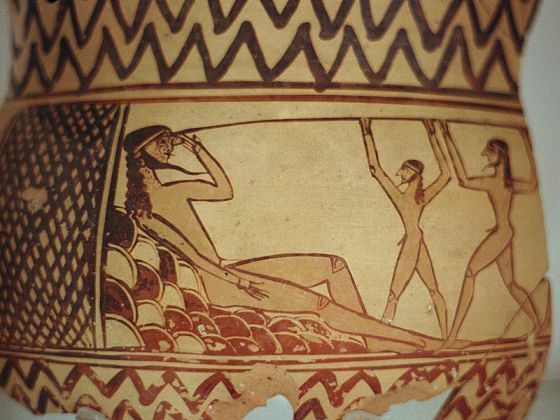
He was also the father of many Giants, like Charybdis, The Whirlpool Monster, the immortal giantess who created a whirlpool in the sea, Laestrygon, the ancestor of the tribe of man-eating giants, Orion, the infamous hunter giant, and Polyphemos, the giant blinded by Odysseus, The Cunning Hero Of The Trojan War.
Divine Children
Poseidon fathered many divine children. Namely:
- Aiolos, the god of the winds
- Asopos, the river-god
- Daimones Proseoous, six spirits haunting the sea caverns in Rhodes
- Despoine, the goddess of Arcadian Mysteries
- Proteus, an elderly sea-god
- Triton, a sea-god with a fish tail
He was also the father of various nymphs, like Aethusa, Herophile, Urea and Rhode, the nymph of Rhodos.
Mortal Children
The list of Poseidon’s mortal children is almost bottomless. We can count over 100 mortal children. Some of his most famous mortal children are:
- Agenor, a king of Phoenicia
- The kings of the Atlantis’ kingdoms: Ampheres, Atlas, Autochthon, Azaes, Diaprepres, Elassipos, Euemon, Eumelos, Mestor, Mneseus
- Augeias, the infamous king of Elis
- Bellerophon, a Corinthian prince and hero
- Boutes, an argonaut
- Euphemos, an argonaut
- Pelasgos, the first king of the Arcadian Pelasgian tribes
- Procrustes, a bandit who amputated or stretched his victims to death
- Skeiron, a bandit who kicked his victims off a cliff to feed a giant turtle
- Thasos, the first king of the homonymous island
- Theseus, a king and hero of Athens
Depiction and Characteristics
Poseidon’s appearance
Poseidon often appears as an older man with sea-green skin and curly hair, always sporting a beard. Furthermore, a large scar marks his left eye.
Often in statues or paintings, artists depict him with seashells and other sea life as he holds his trident. However, many times, one might confuse some Poseidon statues for Zeus and vice versa. Since they are brothers, they both possess many similar physical and mental characteristics.
Other depictions of Poseidon show him riding his chariot drawn by horses with fish tails.
Poseidon’s personality
If we had to describe Poseidon in one word, it would be moody. When he was in a good mood, he could do extraordinary things like create new lands in Mount Olympus’ water or assist humans in achieving their goals.
He could, however, do terrible things when he was angry. He has the ability to cause massive earthquakes, tsunamis, floods, and droughts. Many people died as a result of the outcome. He also used his trident to cause widespread devastation.
He was difficult to deal with because he was argumentative, possessive, and power hungry. He once attempted to dethrone Zeus and seize control of the heavens. When both gods and humans disobeyed him, he punished them both. Poseidon, like his brother Zeus, could be vengeful towards those who have wronged him.
Poseidon’s powers
Poseidon, as one of Cronus’ three sons, possessed incredible strength. He had the ability to submerge islands and lift mountains. As the god of the sea, he ruled over the water and all marine life.
He had the ability to create tsunamis and water funnel clouds, propel himself through the water at incredible speeds, walk on water, cause droughts and floods whenever he pleased, and ride sea waves as a mode of transportation.
He had also mastered hydrogenesis, which allowed him to create water with his power or summon it from thin air. He could also withstand extreme heat and burns.
Being the god of horses gave him the ability to create and rule over them. He could also cause earthquakes, control the weather over the sea, limit the abilities of his offspring, and teleport himself between land and water.
Poseidon’s sacred symbols
The trident, or three-pronged spear, was Poseidon’s sacred symbol. During the Titanomachy, the Cyclopes, One-Eyed Giant Monsters gave it to him as a gift. When he strikes the earth with the trident, he has the potential to cause tsunamis and earthquakes.
Poseidon’s sacred animals and plants
Poseidon’s sacred animals were the horse, the dolphin, and the Cretan bull. The horse represented bravery and beauty. When he wanted to seduce a woman, he transformed into a horse. Many of his offspring were horses, the most famous of which was Pegasus, the winged horse.
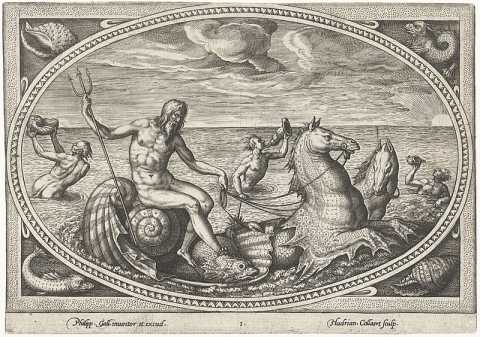
Along with the dolphin, other fish appear to be Poseidon’s sacred animals, such as a winged Hippocampus (Sea horse), which can be seen in Rome’s Trevi Fountain.
The Cretan Bull, The Mighty Beast was one of his sacred animals as well as a symbol of a whole civilization, the Minoan civilization. He gave it to Minos, King of Crete, and made his wife, Pasiphae, fall in love with it and sleep with it. She gave birth to Minotaur, a monstrous creature, as a result of this incident. Furthermore, Poseidon’s sacred plants were the pine tree and wild celery, which were given to the winners of the god’s Isthmian Games as a crown.
Roles and Responsibilities
Poseidon, as one of the most powerful gods, had many roles and responsibilities. His epithet Eurykleion or Eurymedon, which means “wide-ruling,” attests to this.
He was thought to have control over the sea. The god was the protector of fishermen, but he also protected Greek sailors and killed sailors who were seen as a threat to the ancient Greeks.
Poseidon was also the god of earthquakes, as he could either cause or prevent them. That is why he was known as Seisicthon (“the one who shakes the earth”) as well as Themeliouchos (“the one who bears the ground”).
Poseidon was also the taker and tender of horses, the rule of the springs, as well as the leader of the nymphs. Finally, based on his epithets Genesis and Phatrios, he could also be the father of a race or a brotherhood, and he could also be the gatekeeper of Thebes.
Play Poseidon’s Games
Have you paid attention? Do you know everything about this god? Play the game to find out!
You can also play around with Poseidon’s and other Olympian gods’ names in this fun anagram game:
If you want more challenges, try out our other games! For example, this sorting game!
Myths about Poseidon
Rebellion against Zeus
Zeus was notoriously harsh with the other gods. As a result, Hera, Apollo, and Poseidon rose up against him. Hera poisoned Zeus so that the other Olympians could steal his thunderbolt.
Briareus, whom Zeus had liberated from Tartarus, crept into his chamber and untied him. Zeus became enraged and punished all of the gods who participated in the rebellion. Poseidon and Apollo were sent to Phrygia to work as slaves for King Laomedon of Troy for a year. They constructed the famous impenetrable walls that surrounded Troy.
The rivalry of Poseidon and Athena
One year, during Athena’s dissolution festival, a competition between Poseidon and Athena took place to determine who would become the primary god of Athens.
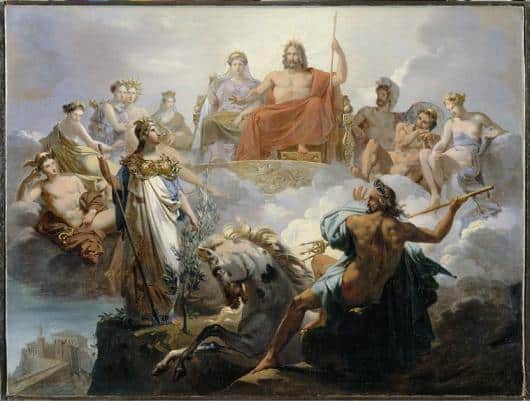
They were asked to give one gift to the people of Athens during their rivalry. So, the Athenians were to choose their preferred gift and the deity to serve as their protector.
Poseidon struck the ground with his trident and a spring appeared, while Athena offered an olive tree. The Athenians chose the olive tree because it provided them with wood, oil, and food. Poseidon became enraged and punished the people of Athens by unleashing a devastating flood.
Poseidon and Minos
Minos was the first King of Crete and the son of Zeus and Europa. He requested an oracle from Poseidon to justify his position as ruler of Crete. Poseidon heard his prayers and sent a bull from the sea for Minos to sacrifice in order to honor Poseidon.
He did not, however, sacrifice the bull; instead, he came to appreciate it and replaced it with a different one. Poseidon became enraged when he found out. As a result, he punished Minos by inducing Pasiphae, his wife, to fall in love with the bull. Pasiphae had feelings for the bull and even mated with it. Following this incident, she gave birth to Minotaur, a half-man, half-bull monster.
Poseidon in Ancient Greek religion
Sites Sacred to Poseidon
The majestic cape Sounion is the most well-known Poseidon sacred site. It is located in Attica’s southern region, seventy kilometers from Athens, on top of a sixty-meter cliff above the Aegean.
Between 444 and 440 BC, the sanctuary was constructed. It was built four kilometers north of the Sounion Cape of fine marble by the renowned architect Ictinus. Ictinus built sixteen Doric columns at the Poseidon temple to withstand extreme weather conditions for many years.
Another Poseidon shrine was found on Tinos, near the Kionia beach. The exact date of its construction is unknown, but it is thought to date from the fourth century A.D. Tinos became an important religious center, where people from all over Greece came to purify themselves.
Poseidon was also honored with a temple on the Isthmus of Corinth. It was built in the seventh century BC, destroyed in 470 BC, and rebuilt as a Poseidon temple in 440 BC. The Isthmian Games were held in that sanctuary, and Poseidon was honored.
In addition, an entire city was dedicated to Poseidon. That city’s name was Helike, and it was located in Achaea, two kilometers from the Corinthian Gulf. Unfortunately, the city no longer exists. It was destroyed by a massive tsunami. There was also a temple dedicated to Helikonian Poseidon.
Worship & Festivals
Poseidon was the king of the sea, and his influence on human life was profound because their daily activities included the sea. As a result, many festivals were held in his honor to ensure his safety.
Then there was the Poseidonia, an annual festival held in Aegina. This was the most anticipated and important festival that took place in December or January. The island’s inhabitants honored the god with wine, merriment, bonfires, and gift-giving.The Isthmian Games, a festival of athletic and musical competitions to honor Poseidon, were also held. It was held at his sanctuary on the Isthmus of Corinth in the spring of each Olympiad’s second and fourth years. Sunium also hosted a larger-scale festival every five years, complete with animal sacrifices.
Representations of Poseidon in Art
In Greek art, Poseidon often rides his chariot, which a hippocampus draws or dolphins accompany. Additionally, he wields his three-pronged trident in various statues and paintings. They also show his palace, which appears to be massive and made of coral and gems.
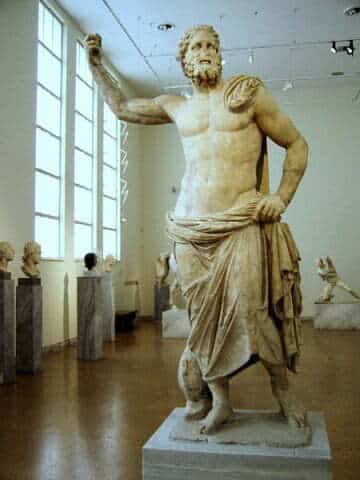
One of the most important representations of Poseidon in classical art is on the Parthenon’s west pediment, which depicts Poseidon and Athena’s rivalry for control of Attica. The statue of Poseidon of Melos, which stands 2.35 meters tall, is also housed in Athens’ National Archeological Museum. The statue was discovered in pieces in 1877, but it has since been repaired.
Poseidon is also depicted in many paintings, including Poussin’s Triumph of Amphitrite, in which he is depicted as Amphitrite’s escort. Furthermore, he appears prominently in Rubens’ oil sketch Neptune Calming the Tempest, in which Poseidon rides a shell-shaped chariot, followed by three blonde-haired nereids. In this painting, he calms the storm to ensure the Cardinal-Infante Ferdinand’s safe passage from Barcelona to Genoa in 1635.
In the old texts
Poseidon played an important role in Homer’s epic poems, the Iliad and Odyssey. There he supported the Greeks in the Iliad, where Homer narrates the Trojan War between the Greeks and the Trojans, by giving inspirational speeches and leading them in battle.
Poseidon does not appear to be supportive in The Odyssey, where the central theme is Odysseus’ journey home after the Trojan War, as he cursed Odysseus to wander the sea for ten years. He had changed his mind about this Greek hero because Odysseus had blinded his son, Polyphemus.
Hesiod was another Greek poet who wrote about Poseidon. He described the origins of the gods in his work Theogony. He described Poseidon as the earth holder who had the power to shake the earth.
Hesiod and Homer referred to him as the Earth-shaker, but they also described him as an earth encircler. Interestingly, they associate this epithet with the ancient belief that all of Earth’s waterways were connected and that land floated on top of them.
FAQs
Poseidon was the god of the sea, the earthquakes, and the horses.
Poseidon’s parents were Cronus and Rhea.
He had three brothers and sisters: Hestia, Hades, Hera, Zeus, Demeter, and Chiron, The Wise Centaur.
The number of his children remains unknown, but he had much more than Zeus had.
Amphitrite
Njord
Sources
Callimachus
- Fragment 207
Hesiod
- Theogony 270, 930
Homer
- Iliad 14.326
- Odyssey 11.236, 11.305
Ovid
- Metamorphoses 4.786, 6.118
Pausanias
- Description of Greece 8
Pindar
- Olympian Ode 6
Pseudo-Apollodorus
- Bibliotheca 2
Featured Image Credit: Stefano Bolognini, Attribution, via Wikimedia Commons

